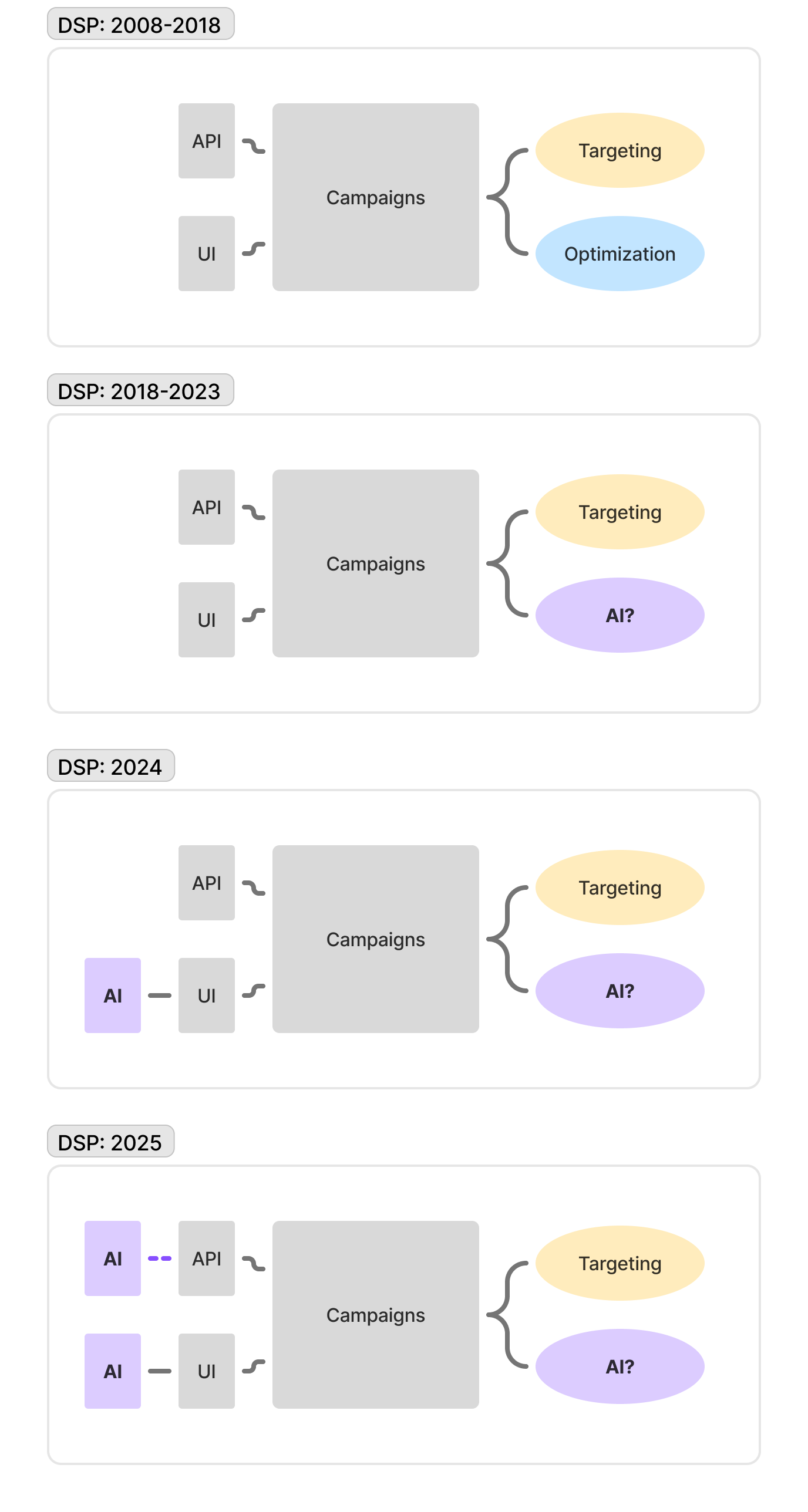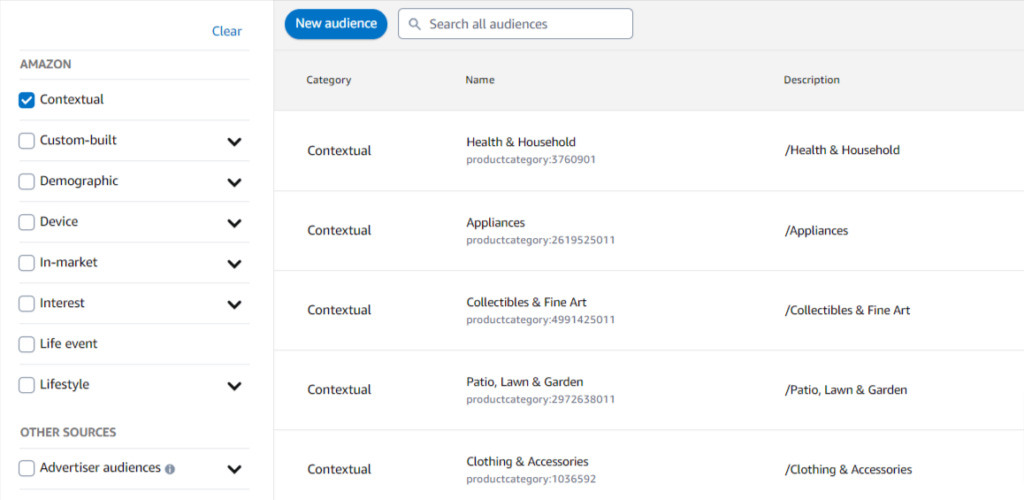Vibe Targeting
Prompts aren't for setting up targeting. They ARE the targeting.
A very brief history of AI in ad tech
I’m writing this in June 2025, so future humans will probably laugh and say “you had no idea what was coming.” But let me take a shot. Let’s start with a quick look at the history of AI in ad tech:
Pre-2024: Rebranded machine learning
The first cycle of AI was companies rebranding their data science and machine learning efforts as AI. For instance, “TTD introduced AI-based optimization to its platform through the 2018 launch of Koa. Initially focused on optimizing campaigns, Koa now also features deep neural networks dedicated to several different applications.”
2024: Setup assistant
In 2024 the big idea was to add an AI-powered chat box. For instance, ViantAI, which lets the user set up a media plan with a conversational UI. You approve the plan and it sets up all of the campaigns and targeting and other objects. When the campaign is running, you can ask it questions about performance and results and it will summarize them for you.
Early 2025: Agent orchestration
In 2025, we’ve seen every agency and myriad startups announce agent orchestration workflows like this one from Newton Research where an agent sets up a plan and calls out to other agents.
A very brief history of ad tech in diagrams
I like diagrams, so let’s look at those systematically (and thank you to Anne Coghlan for helping me with these!)
Following that flow, it seems like the next step is clear: targeting goes AI. It makes sense. The current targeting experience is immensely complicated. It requires an entire periodic table to understand. Hundreds of vendors selling data. Thousands of PMPs. Millions of websites. AOTW (that’s Acronyms Out The Wazoo if you’re not familiar with it).
Targeting via Taxonomy
Think of a brand. Think of a product. Write a few sentences describing a target customer. Got it?
Here’s mine, possibly based on what I see in the mirror. Let’s call this our “brand story” - one of multiple or many that we might have based on consumer research, product marketing, and other data:
Vibram Five Fingers running shoes for men looking to reconnect with their inner athlete, probably after they read the book "Born to Run." They are not in great shape but are trying very hard, are iconoclastic enough to not care how ridiculous they look wearing them, and are probably the kind of people who try other unusual diets and methods like Keto, intermittent fasting, and other fads going around the health-industrial complex.Ok, now here’s the Amazon targeting interface in their DSP:
Challenge: what are you going to click to find this audience? Maybe demographic, interest, lifestyle, contextual?
Here’s what Claude says:
Looking at the IAB Content Taxonomy, here are the most relevant categories for Vibram running shoes:
Primary Categories:
Sports > Track and Field - Since these are running shoes specifically designed for athletic performance
Style & Fashion > Men's Fashion > Men's Shoes and Women's Fashion > Women's Shoes - As they are footwear products
Healthy Living > Fitness and Exercise - Given their use in fitness activities and running
Secondary Categories:
Sports > Running and Jogging - If this subcategory exists in your IAB version
Shopping > Sporting Goods - For e-commerce and retail contexts
Hobbies & Interests > Running/Jogging - For content about running as a hobby
Additional Considerations:
Healthy Living > Wellness - Since Vibram FiveFingers shoes are often marketed for their biomechanical benefits and "barefoot" running approach
Technology & Computing > Consumer Electronics - Only if focusing on any tech features (like smart insoles or tracking capabilities)
The most appropriate category would depend on the specific context - whether you're categorizing content for advertising, content management, or audience targeting. For pure product categorization, I'd prioritize the Sports/Track and Field or Fitness and Exercise categories, as they best capture the primary use case of these specialized running shoes.
Blerg. That is a lot of random categories. Maybe Healthy Living → Wellness is the best fit if we want to find content for the kind of person that would be interested in these shoes.
Introducing Vibe Targeting
What if, instead of having to translate our brand story into a bunch of checkboxes and taxonomies, we could just give the DSP the brand story directly?
This example shows my prompt being translated into sample articles. This is a contextual example, but of course there’s no reason this approach wouldn’t work across all of these targeting types - in fact, I would argue that this is a much more powerful approach because it will pick up new targeting and datasets automatically.
The most important point is that this isn’t using our prompt to configure targeting. Our prompt IS the targeting.
And YOU are in charge. YOU build the agent. YOU do the prompt engineering. YOU can copy and paste your prompt, modify it, port it to another platform. YOU are the creative engine. AI just helps you run the darn thing.
Here’s a prototype that I vibe coded. It’s public if you want to give it a try, you just need a Scope3 account (free!) to log in.
Building for Vibe
How would we practically integrate Vibe Targeting into a DSP? Initially, it will be through third-party products like Scope3 Brand Stories, which will be integrated into the data marketplaces of DV360, Trade Desk, and Amazon DSP by mid-summer. Brands and agencies will log into Scope3 to build and calibrate their prompts. Once they’re working as expected, users will log into the DSP, set up a campaign, and select their Brand Story in the Scope3 section of the targeting taxonomy.
Does this become a built-in feature (or the default!) in DSPs so that you don’t have to leave the DSP to build your prompt? Or does centralized management of prompts, calibration, and fine-tuning become a new product category - the “third-party prompt server” - that uses reporting and measurement data from multiple platforms to refine the algorithm?
The most important point is that we have to have guardrails. As Ruben Schreurs says “A major advertiser can't just vibe code, vibe target, or vibe anything without making absolutely sure they’re protecting their brand and IP. But if you bring together the option to be storyteller and vibe targeter, with superb controls/guardrails/best practices/compliance etc built in - BOOM.”
There are lots of details to work out. The agent needs reporting data to optimize results over time. Campaigns need to be set up around brand stories and their variants. Agency folks need to be trained to prompt engineer. Ad tech pundits have to weigh in. It’s a lot! But I’m pretty confident it’s going to happen… and sooner than you think.











Thank you BOK. I've shared this with a bunch of industry friends and My Son in digital ad sales.
I sent you an email but I guess it didn't reach you.